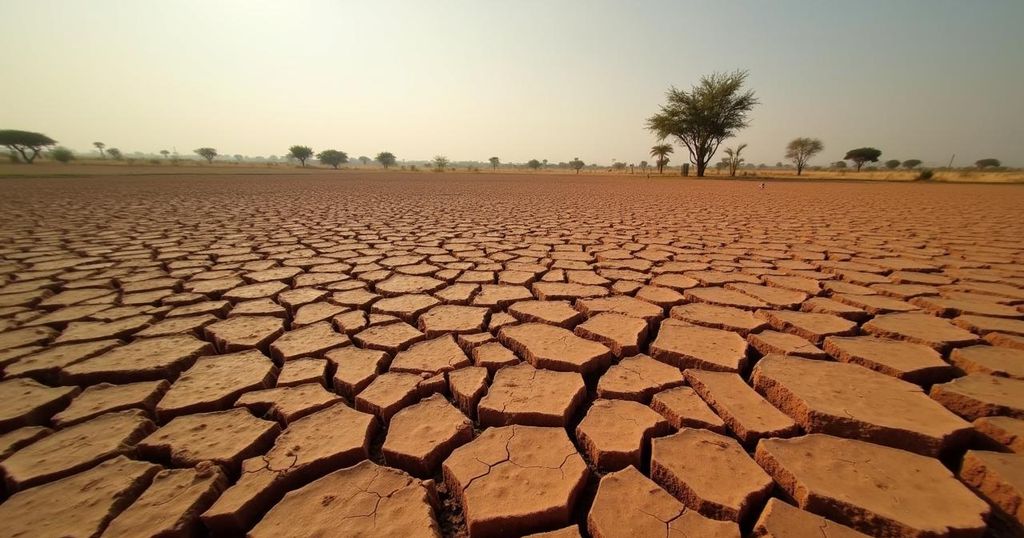Southern Africa is enduring its worst drought in a century, affecting over 27 million people, with 21 million children malnourished. Countries such as Lesotho, Malawi, Namibia, Zambia, and Zimbabwe have declared national disasters as rainfall shortages have devastated crops and livestock, exacerbated by the effects of climate change. The crisis is projected to worsen until early next year when the next harvests are anticipated.
The Southern Africa region is currently grappling with a catastrophic drought, recognized as the worst in a century, impacting more than 27 million individuals. Children are particularly vulnerable, with approximately 21 million suffering from malnutrition, according to reports from the United Nations’ World Food Programme (WFP). Countries including Lesotho, Malawi, Namibia, Zambia, and Zimbabwe have recently proclaimed national disasters as the drought decimates crops and depletes livestock. Angola and Mozambique are also experiencing significant adverse effects, with the situation anticipated to worsen until the next harvest cycle in March or April of the coming year. WFP spokesperson Tomson Phiri stated, “A historic drought – the worst food crisis yet – has devastated more than 27 million lives across the region. Some 21 million children are malnourished.” The onset of October marks the beginning of the lean season for Southern Africa, with expectations that conditions will deteriorate monthly until the upcoming harvests next spring. The drought has led to crop failures, livestock deaths, and malnourished children, with many fortunate to receive just a single meal daily. The region’s reliance on small-scale agriculture, predominantly rain-fed, exacerbates the crisis. Aid organizations had issued warnings regarding potential disasters late last year as the El Niño weather phenomenon contributed to inadequate rainfall. This situation has been exacerbated by elevated temperatures attributed to climate change. In July, UN officials characterized this drought as unparalleled in the last century, highlighting destruction levels such as the eradication of 70 percent of Zambian harvests and 80 percent in Zimbabwe, as stated by WFP’s acting regional director for southern Africa, Lola Castro. The drought has not only affected food production but has also diminished hydropower capacity, resulting in significant electricity shortages within the region. In response, authorities in Zimbabwe and Namibia have implemented wildlife culls, including elephants, to alleviate resource pressures and provide meat for the starving populace. Experts indicate that sub-Saharan Africa’s vulnerability to climate change is heightened by its reliance on rain-dependent agriculture and natural resources. Millions within the region are prone to climate-related adversities, while many nations lack the financial means to invest in climate resilience measures. Furthermore, climate change has been shown to adversely affect the yield, development, flavor, and harvest periods of various agricultural products.
Southern Africa is currently facing a dire humanitarian crisis marked by a historic drought, primarily driven by climate change, resulting in severe food insecurity, especially among children. The alarming statistics of malnourishment among children and the vast number of individuals affected underscore the urgent need for intervention and support from international organizations. The reliance on rain-dependent agriculture leaves the region particularly susceptible to prolonged adverse weather patterns, exemplified by the recent El Niño phenomenon. As the drought situation escalates, so too do the socioeconomic challenges, leading to significant disruptions in food supply chains and critical electric power shortages.
In conclusion, the drought sweeping across Southern Africa represents an unprecedented humanitarian crisis, with millions at risk of starvation and severe malnutrition, particularly among children. With the potential for worsening conditions leading up to the next harvest cycle, there is an urgent call for immediate international assistance to combat the ramifications of climate change and ensure food security within this vulnerable region. The realities of climate dependency, agricultural failure, and escalating resource scarcity emphasize the critical need for sustainable practices to enhance resilience against future climatic challenges.
Original Source: www.aljazeera.com







